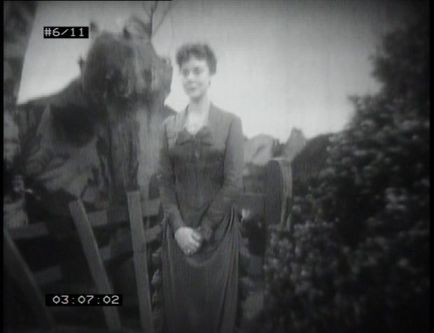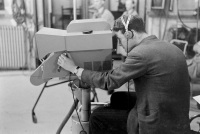 Reviewing for The Listener a 1953 BBC television production of Ibsen’s poetic play The Lady from the Sea, Philip Hope-Wallace wrote that the dramatist ‘has recently been hailed as the perfect television playwright.’ (‘Enough of water hast thou…’, 21 May 1953, p. 856) I wish I could track down his reference, not least because it might help us understand why quite so many Ibsen dramas were produced for the small screen during the 1950s (eighteen by my current count). Hope-Wallace was writing about the earliest to survive – producer Harold Clayton’s richly interesting studio presentation that is distinguished by a compelling performance from Irene Worth. This production is the focus of my last substantive post of 2011 (I have one other yet to complete).
Reviewing for The Listener a 1953 BBC television production of Ibsen’s poetic play The Lady from the Sea, Philip Hope-Wallace wrote that the dramatist ‘has recently been hailed as the perfect television playwright.’ (‘Enough of water hast thou…’, 21 May 1953, p. 856) I wish I could track down his reference, not least because it might help us understand why quite so many Ibsen dramas were produced for the small screen during the 1950s (eighteen by my current count). Hope-Wallace was writing about the earliest to survive – producer Harold Clayton’s richly interesting studio presentation that is distinguished by a compelling performance from Irene Worth. This production is the focus of my last substantive post of 2011 (I have one other yet to complete).
One of my most vivid theatrical memories is of Vanessa Redgrave’s Ellida in a Manchester Royal Exchange production of The Lady from the Sea at the Roundhouse in the late 1970s. Her daughter Joely Richardson takes on the role early in 2012 at the Rose Theatre Kington (23 February-17 March) and I’m hugely looking forward to that. It’s a glorious part, but the character and the play’s events can all too easily appear absurd. But that is unquestionably not the case in the blurry and occasionally imperfect film record of the BBC’s 1953 live production that was given twice, on a Sunday and a Thursday evening in the same week.
I am uncertain about whether the recording is of the first or the second performance – the cover of the BBC’s archive DVD indicates that it is the earlier one, but my understanding is that these first film recordings were only shot from monitors during the second run. In any case, this is the second-oldest recording of any British television drama (at least at present, although let’s hope others come to light). Produced two months later than ‘It is Midnight, Doctor Schweitzer’ (for details of which, see my earlier post), The Lady from the Sea has a far superior script, more fluid and focussed studio camerawork and better performances throughout, and overall is a far more satisfying experience. Indeed, even nearly sixty years on, few allowances have to be made for it to be enjoyed as small-screen drama of the first order.
 Ibsen apparently drafted some notes for The Lady from the Sea just after the conclusion of A Doll’s House in 1880. Yet it was eight years later that he settled to write a story that echoes the themes of women’s identity and emancipation in the earlier play. Ellida is the second wife of a well-meaning doctor, Paul Wangel (played by Robert Harris), who has two daughters from his earlier marriage. Ellida and Paul have been together for some years, but their relationship is troubled and unsatisfactory. She yearns for something more or someone else, and for a freedom symbolised by her daily sea bathing. A mysterious seaman arrives reminding Ellida of a pledge that she made to him many years before; he has come to take her away with him. She is forced to choose between Paul and the character who is referred to as Freiman but to do so she has first to assert her autonomy from the social and mental constraints of her marriage.
Ibsen apparently drafted some notes for The Lady from the Sea just after the conclusion of A Doll’s House in 1880. Yet it was eight years later that he settled to write a story that echoes the themes of women’s identity and emancipation in the earlier play. Ellida is the second wife of a well-meaning doctor, Paul Wangel (played by Robert Harris), who has two daughters from his earlier marriage. Ellida and Paul have been together for some years, but their relationship is troubled and unsatisfactory. She yearns for something more or someone else, and for a freedom symbolised by her daily sea bathing. A mysterious seaman arrives reminding Ellida of a pledge that she made to him many years before; he has come to take her away with him. She is forced to choose between Paul and the character who is referred to as Freiman but to do so she has first to assert her autonomy from the social and mental constraints of her marriage.
 There is, as you might suspect, a good deal more to Ibsen’s drama, which is rendered here in a idiomatic and pleasingly contemporary adaptation by Max Faber. The two daughters (finely played by Sarah Lawson and Jane Wenham) work out variations on questions of responsibility, duty and freedom in exchanges with their respective suitors. And the playwright suggests strands of the supernatural and the spiritual which contrast with while at the same time being neatly complemented by Roy Oxley’s studio settings. Yet this is a play dominated by Ellida and a production that belongs triumphantly to Irene Worth (1916-2002).
There is, as you might suspect, a good deal more to Ibsen’s drama, which is rendered here in a idiomatic and pleasingly contemporary adaptation by Max Faber. The two daughters (finely played by Sarah Lawson and Jane Wenham) work out variations on questions of responsibility, duty and freedom in exchanges with their respective suitors. And the playwright suggests strands of the supernatural and the spiritual which contrast with while at the same time being neatly complemented by Roy Oxley’s studio settings. Yet this is a play dominated by Ellida and a production that belongs triumphantly to Irene Worth (1916-2002).
Irene Worth must have left London just days after this production for Stratford, Ontario and Tyrone Guthrie’s triumphant debut festival famously mounted in a big, leaky tent. (The Canadian Adaptations of Shakespeare Project website includes a fascinating page about a film documentary, The Stratford Adventure, made at the time about that extraordinary initiative.) Eric Shorter’s 2002 Guardian obituary is a reminder that the actress ‘relished improvisation, and preferred the experimental’ and that she was a dazzling Goneril in Peter Brook’s landmark production of King Lear in 1962, and then later in his 1971 film.
 Whether speaking or – more often – listening in The Lady from the Sea, Irene Worth demands attention and captures the eye in just the way that I recall Vanessa Redgrave doing at the Roundhouse. She is by turns elated (with her wet hair flying free, as right), deeply troubled, strong, touching, passionate, grand, vulnerable and loving, both towards Paul and – finally – to his daughters. And as Philip Hope-Wallace astutely observed back in 1953, ‘[producer] Harold Clayton’s handling of Ellida was masterly; never a cut in the wrong place, never a point missed.’ The camera rests on her face as at the end of Act I as she listens to the tale that first alerts her to the seaman’s return, just as it does in Act II when she recounts her earlier meetings with Freiman. There is no movement in either shot, but there is a broad range of expression and meaning. as well as pointed dramatic tension.
Whether speaking or – more often – listening in The Lady from the Sea, Irene Worth demands attention and captures the eye in just the way that I recall Vanessa Redgrave doing at the Roundhouse. She is by turns elated (with her wet hair flying free, as right), deeply troubled, strong, touching, passionate, grand, vulnerable and loving, both towards Paul and – finally – to his daughters. And as Philip Hope-Wallace astutely observed back in 1953, ‘[producer] Harold Clayton’s handling of Ellida was masterly; never a cut in the wrong place, never a point missed.’ The camera rests on her face as at the end of Act I as she listens to the tale that first alerts her to the seaman’s return, just as it does in Act II when she recounts her earlier meetings with Freiman. There is no movement in either shot, but there is a broad range of expression and meaning. as well as pointed dramatic tension.
The studio cameras are used with intelligence and precision elsewhere, as when Arnholm (Eric Berry) offers to help Boletta escape from her family, which is shown in a high two-shot favouring the sister. Then, as she realises he is declaring his love for her, she backs away from him and the shot closes in and follows her, isolating the character as she turns from him.
The most striking moment, however, is again centred on Ellida, with an extended moment of concentrated stillness as she senses the arrival of Freiman. She is shown full-length, unmoving, both anticipating and afraid of what is to come (a framegrab heads this post). Responding to Irene Worth’s performance in The Manchester Guardian ‘our radio critic’ wrote,
… it was a sensitive and moving performance and one that was intensely alive. But indeed there was no part of passage in this play that was not alive and compelling to the attention, and of how few television plays that can be said. (‘Television: The Lady from the Sea’, 13 May 1953, p. 5)
The production makes a fascinating contrast with the version of Ibsen’s The Wild Duck produced by John Saville for the stage in 1955 and on 35mm film in 1957 for Associated-Rediffusion; I blogged about this when it was screened at BFI Southbank earlier this year. The Lady from the Sea was also staged for the BBC by Michael Elliott in 1958, but this has been lost, and by director Basil Coleman as a Play of the Month in 1974 – look out for a 2012 comparative blog about that production.

Discussion
Trackbacks/Pingbacks
Pingback: The Passionate Pilgrim (1953) | Forgotten Television Drama - 8 July 2015